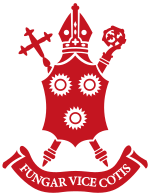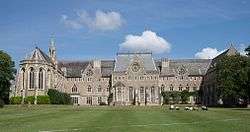St Edmund's School Canterbury
 | |
 | |
| Motto |
"Fungar Vice Cotis" (Be as a whetstone for others to be sharpened upon) |
|---|---|
| Established | 1749 |
| Type | Independent day and boarding |
| Religion | Church of England |
| Headteacher | Louise Moelwyn-Hughes |
| Location |
St Thomas' Hill Canterbury Kent CT2 8HU England 51°17′30″N 1°03′35″E / 51.2917°N 1.0597°ECoordinates: 51°17′30″N 1°03′35″E / 51.2917°N 1.0597°E |
| Local authority | Kent |
| DfE number | 886/6050 |
| DfE URN | 118998 |
| Students | 570 |
| Gender | Coeducational |
| Ages | 3–18 |
| Website |
www |
St Edmund's School, Canterbury is an independent day and boarding school located in Canterbury, Kent, England for girls and boys aged 3-18, including the Choristers of Canterbury Cathedral.
History
St Edmund's School Canterbury was first established in 1749, as the Clergy Orphan Society (later the Clergy Orphan Corporation) in Yorkshire. In 1812, the school moved to St John's Wood at the nursery end of Lord's Cricket Ground. An associated school for girls was located on the same site, but later moved to become St Margaret's School, Bushey in Hertfordshire.
In 1855, the school moved to Canterbury. The acquisition of property and financing to build the school was provided by Samuel Warneford. The main school building was designed by the architect Philip Charles Hardwick, while the chapel was completed in 1858.
In 1982, girls were admitted to the school.[1]

Heads
The name of the first Headmaster, between the years 1751 and 1762, is unknown.
The Revd Daniel Addison (1762 - 1783)
The Revd Daniel Addison (1783 - 1804)
The Revd Thomas Cripps (1804 -1805)
The Revd Evan Jones (1805 - 1813)
The Revd William Farley (1813 - 1816)
The Revd Thomas Wharton (1817 - 1837)
The Revd George Bewsher (1837 - 1841)
The Revd. Daniel Butler (1841 - 1867)
The Revd Charles Matheson (1867 - 1891)
The Revd Arthur W. Upcott (1891 - 1902)
The Revd Edward J.W. Houghton (1902 - 1908)
The Revd Walter F. Burnside (1908 - 1932)
The Revd Henry Balmforth (1932 - 1941)
The Revd Frederick F.S. Williams (1942 - 1945)
William M. Thoseby (1945 - 1959)
Walter Stephen Jones (1 term 1959)
B. Michael S.Hoban (1960 - 1964)
Francis R. Rawes (1964 - 1978)
John V. Tyson (1978 - 1994)
A. Nicholas Ridley (1994 - 2005)
Jeremy M. Gladwin (2005 - 2011)
Louise J. Moelwyn-Hughes (2011 - current)
Reviews
In 2015 The Good Schools Guide reported “if you want a school which is going to take great care of your child, and get the best out of him/her, whether s/he’s a Cambridge or C grade student, definitely one for the shortlist.” and “It’s a school with a smile on its face, a great sense of ease and happiness pervades.” [2]
The Independent Schools Inspectorate report of 2015 commented that “The quality of boarding is excellent.” [3]
Facilities
The historic main building with its fine stone work houses classrooms, boarding facilities, oak-panelled dining hall, library and administration offices. Further buildings provide teaching areas for Art, Design Technology and Science. The Francis Musgrave Performing Arts Centre comprises a purpose-built music school (opened by Freddy Kempf) with recording studio and recital hall as well as a 450-seat theatre for concerts and drama productions. Sports facilities include sports hall, gym, all-weather astro pitch, playing fields and swimming pool. Additional boarding houses are set in the grounds of the school. The Junior School and Pre-Prep School are located on the same site in their own buildings. Located in beautiful grounds overlooking the vibrant city of Canterbury, the school benefits from excellent transport links to London and operates a minibus service for pupils travelling from outside of Canterbury and London. The Archbishop of Canterbury is the school’s patron.
Houses
In Senior School is divided into four day houses: Baker, Wagner, Warneford and Watson with one overall boarding house, Owen. In Junior School there are four houses: Becket, Chaucer, Marlowe and Roper.
Cathedral choir
In 1972, the previously independent Canterbury Cathedral Choir School, which educated the choristers of Canterbury Cathedral, joined the Junior School as the Choir House. Choir House remains at a detached location beside the cathedral, and a minibus service conveys the choirboys between the two sites.
Notable former pupils
Former pupils are granted membership to St Edmund's Society.
- Willoughby Allen, priest
- Jon Baddeley, auctioneer
- Orlando Bloom, actor
- Thomas Crick, Anglican priest
- Lawrence Durrell, novelist
- Benjamin Handley Geary, soldier
- Darren Henley, Chief Executive of Arts Council England
- Hope Gill, Anglican bishop
- Michael Goodliffe, actor
- Sanjeev Gupta, industrialist
- Bernard Howlett, soldier
- Geoffrey Iliff, Anglican bishop
- Robin Jackman, cricketer
- Freddy Kempf, pianist
- John Long, priest
- Arthur Lovekin, journalist and politician
- Nigel MacArthur, broadcaster
- Gordon Holmes MacMillan, soldier
- Chris Nickols, Royal Air Force officer
- Alan Payne, cricketer
- John Peacey, cricketer
- John Pinsent, classicist
- Roger Royle, priest and broadcaster
- Hedley Sparks, Anglican priest and academic
- Max Spiers, conspiracy theorist
- Mark Strudwick, soldier
- Stuart Townend, athlete, soldier and schoolmaster
References
External links
| Wikimedia Commons has media related to St Edmund's School. |